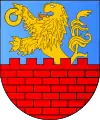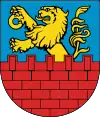Nasielsk
Nasielsk [ˈnaɕelsk] is a small town in Masovian Voivodeship, Poland. It is located on a major Warsaw-Gdańsk rail line and serves as a junction, with an additional connection to Sierpc.
Nasielsk | |
|---|---|
.jpg.webp) Skyline of the town | |
 Flag  Coat of arms | |
 Nasielsk  Nasielsk | |
| Coordinates: 52°36′N 20°48′E | |
| Country | |
| Voivodeship | Masovian |
| County | Nowy Dwór Mazowiecki |
| Gmina | Nasielsk |
| Established | 9th century |
| First mentioned | 1065 |
| Town rights | 1386 |
| Government | |
| • Mayor | Bernard Dariusz Mucha |
| Area | |
| • Total | 12.67 km2 (4.89 sq mi) |
| Population (2006) | |
| • Total | 7,364 |
| • Density | 580/km2 (1,500/sq mi) |
| Time zone | UTC+1 (CET) |
| • Summer (DST) | UTC+2 (CEST) |
| Postal code | 05-190 |
| Area code(s) | +48 23 |
| Car plates | WND |
| Website | https://nasielsk.pl/ |
History
.jpg.webp)
An early Lechitic (proto-Polish) stronghold was built in the 9th century, and the region became part of the emerging Polish state in the 10th century. Nasielsk was first mentioned as Nosidlsk in 1065, in the so-called Mogilno Falsification of King Bolesław II the Generous for the Benedictine Abbey at Mogilno. As the document stated, the gord of Nosidlsk was an important center of defence, trade and administration. In the past, the name of the town was spelled in different forms: Nasilzco, Nosidlsk, Nosylsk, Nosydlsk, Nosielsk, Nosselia, Nosidlsko, Nasidlsko, Nosilsko, Nasilsko, Nasylsco. In 1155, a document issued for Duke Boleslaw Kedzierzawy confirmed the existence of the gord at Nasielsk, stating that Nowa Wies near Nasielsk was granted to the abbey of Czerwińsk nad Wisłą. In 1257, Duke of Siemowit I of Masovia granted one-third of Nasielsk to the Czerwinsk Abbey.
By the late 13th century, Nasielsk emerged as the seat of a castellany. First document that confirms this fact was issued in 1297, with the notice of „comes Thomas castellanus de Nosylk”. On November 11, 1386, Janusz I of Warsaw granted the remaining part of the town of Nasielsk (civitas Nostra Nosielsko) to knight Jakusz of Radzanow (Prawdzic coat of arms). Jakusz, who came to be known as Jakusz Bialy of Nasielsk, became the castellan of Nasielsk, and the town remained the property of his family until 1647. The coat of arms of Nasielsk is based on the Prawdzic symbol.
The town with its wooden church of Saint Adalbert of Prague burned in 1440, and five years later, a new brick church was erected. Nasielsk for centuries remained in private hands of the Nosielski and Wessel families. In mid-18th century, first synagogue was built, and in 1795, following the Third Partition of Poland, Nasielsk was incorporated into the Kingdom of Prussia, where it remained until 1807, when it became part of the short-lived Polish Duchy of Warsaw, and afterwards it was incorporated into Russian-controlled Congress Poland in 1815. Until 1866, Nasielsk was a private town. In 1877, a rail line from Warsaw to Gdańsk via Nasielsk was completed.
In 1918, Nasielsk returned to Poland, as the country regained independence. During the Polish-Soviet War, in August 1920, Polish forces won the Battle of Nasielsk against the advancing Red Army. In 1924, the town became a rail junction after completion of a line to Toruń.
Following the joint German-Soviet invasion of Poland, which started World War II in September 1939, the town was occupied by Germany until 1945, and the population was subjected to various atrocities. In April 1940, the Germans arrested the pre-war Polish mayor Feliks Rostkowski, and imprisoned him in a concentration camp, however, he survived and returned to Nasielsk after the war. In December 1940, the Germans expelled around 1,000 Poles from the town.[1] Expelled Poles were held in a camp in Działdowo for two weeks, where they were stripped of valuables, and then deported in freight trains to the Radom District of the General Government, while their houses and workshops were handed over to German colonists as part of the Lebensraum policy.[1] From 1941 to 1943, the Germans operated a forced labour camp in the town.[2]
The first official inventory of important buildings in Poland, A General View of the Nature of Ancient Monuments in the Kingdom of Poland, led by Kazimierz Stronczynski from 1844–55, describes the Nasielsk Synagogue as one of Poland's architecturally notable buildings.[3]
In 2009, Glenn Kurtz stumbled upon a home video shot by his family that included three minutes of footage in Nasielsk shot in 1938. Kurtz set out to restore the film and find the people in it. The book based on this journey is titled Three Minutes in Poland: Discovering a Lost World in a 1938 Family Film.[4]
Sports
The local football club is Żbik Nasielsk, with both men and women teams.[5] Both teams compete in the lower leagues.
Notable people
- Dovid Bornsztain (1876–1942), third Sochatchover Rebbe
- Ola Jordan (born 1982), Polish-British professional dancer on the British TV show Strictly Come Dancing
- Renata Mauer (born 1969), sports shooter, double Olympic champion
- Tomasz Majewski (born 1981), shot putter, double Olympic champion
Notable fictional characters from Nasielsk
T. O. Morrow (real name Tomek Ovadya Morah), DC Comics supervillain
External links
- Jewish Community in Nasielsk on Virtual Shtetl
- Glenn Kurtz's family video showing Nasielsk in 1938
References
- Wardzyńska, Maria (2017). Wysiedlenia ludności polskiej z okupowanych ziem polskich włączonych do III Rzeszy w latach 1939-1945 (in Polish). Warszawa: IPN. p. 397. ISBN 978-83-8098-174-4.
- "Arbeitserziehungslager Nasielsk". Bundesarchiv.de (in German). Retrieved 2 January 2021.
- Heaven's Gates; Wooden synagogues in the Territories of the Former Polish-Lithuanian Commonwealth, maria and Kazimierz Piechotka, Wydawnictwo Krupski i S-ka, Warsaw, 2004, p. 174
- https://www.npr.org/2014/11/16/364051174/family-film-offers-glimpse-of-three-minutes-in-poland-before-holocaust
- "MLKS "Żbik" Nasielsk" (in Polish). Retrieved 2 January 2021.
